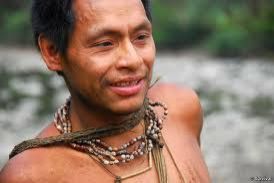Peru Debates Whether To Start Gas Extraction In Protected Amazon Area; Local Tribe Nahua Not Pleased

The natural reserve of Kugapakori, in the Peruvian Amazon, and its native inhabitants, the indigenous Nahua tribe, have been capturing the attention of the Peruvian government for days. The area, rich in gas resources, is close to the Camisea gas extraction site, and the government is now considering expanding the drilling to Kaguapakori.
The country is divided among those who want to enlarge the exploration, and those who want to protect the reserve and its people.
The issue goes deeper than this particular case: since the 1980s, Peru has vouched to protect isolated native tribes, like the Nahua, after several indigenous groups were damaged by the first gas explorations. At the same time, President Ollanta Humala has promised affordable energy for all Peruvians, and the potential reserves from Kugapakori would be the ideal solution to provide just that. “This section of Camisea is destined to local use, and the costs are regulated, so it won’t spiral out of control,” Minister for Energy and Mining Jorge Merino said.
Located in the southern province of Cusco, the area was named a national reserve in 1990. Thirteen years later, it was designated as a territorial reserve for three indigenous groups who had been particularly harmed in the 1980s. Kugapakori borders the National Park of Manu, an environmentally protected area and a tourist attraction, which could also be affected by the explorations.
The Camisea project, by Argentinian oil company Pluspetrol, is the biggest gas extraction site in the country.
The Ministry of Culture wrote a report on the issue in July, indicating that the damage to the native tribes could be severe, and suggesting as many as 83 different changes to the project. The government, however, rejected the plan and is waiting for a revised report.
Peruvian anthropologist Beatriz Huerta pointed out that the rejected report was probably right. “The risk is enormous. It could even lead to extinction,” she told Spanish newspaper El País. “These populations are incredibly vulnerable -- they are not immunologically prepared to the changes, and they are not at all familiar with the processes, which could be a major psychological impact.”
Pluspetrol, on the other hand, disputes that the Nahua even exist. “There has not been any evidence of their existence in the last five years,” Nelson Soto, a company spokesman said, adding that their workers always have a native guide who knows the area well.
Peruvian ombudsman Eduardo Vega wrote personally to Prime Minister Juan Jiménez to ask the government to “do what they promised and protect the indigenous reserves,” and demand two different reports on possible impact. Jiménez replied that the project would continue its legal process, which includes impact studies.
In July, two chiefs from a Nahua group, the Serjali, who live in Kugapakori, wrote a letter to the Ministry of Culture, reported local newspaper La República.
“We want to manifest our worry over how much our government has forgotten about us,” read the letter, in Spanish. “We are not going to permit the works of Pluspetrol in our land. This company has mocked our ancestral history and our rights.”
Pluspetrol hasn't commented on the letter.
© Copyright IBTimes 2024. All rights reserved.





















